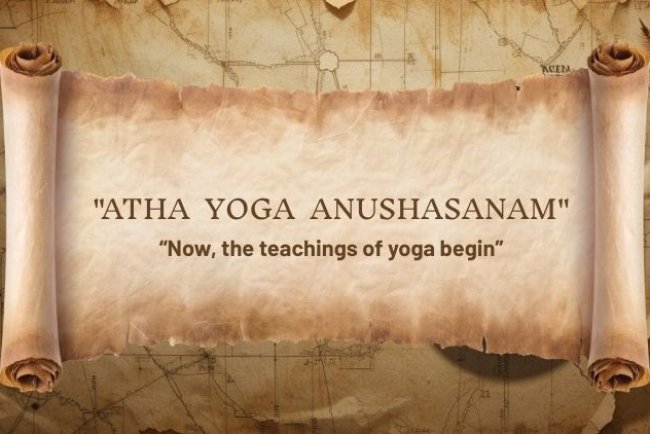Yoga Sutra 1.2: Yogas Chitta Vritti Nirodha

Nearly 2,000 years ago, the sage Patanjali laid the foundation for the systematic practice of yoga. His teachings were expressed through brief, profound, and easily memorizable sayings—sutras—which could be chanted like ślokas. Interestingly, the word sutra shares a root with the modern English term slogan, which we now associate with catchy marketing phrases like "It's the real thing" or "Be all that you can be."
But if yoga were to have a timeless, all-encompassing slogan, it would be found in Yoga Sutra 1.2: "Yogas Chitta Vritti Nirodhah."
This sutra defines yoga not as physical movement, but as a state of stillness—where the mental fluctuations (vrittis) come to rest. Just as a stone dropped into water causes ripples, every sensory input triggers waves of thought in the mind. These thought-waves lead to reactions, which in turn shape our habits, character, and ultimately, our destiny. This ongoing cycle—driven by unchecked thoughts and reactions—is what keeps us bound in Samsara, the loop of birth and death.
Patanjali offers a clear solution: to still the waves of the mind. This is yoga—the path to freedom from suffering and a return to one’s true nature.
What is Yogas Chitta Vritti Nirodha?
“Yogas chitta vritti nirodhah”
— Yoga is the stilling of the fluctuations of the mind.
This iconic line is often translated as:
“Yoga is the regulation or cessation of the modifications of the mind.”
While it may not sound as catchy as “Just do it,” this sutra is far more profound—because it's not just a phrase, it’s an experience.
You've likely felt it:
-
That blissful stillness after a deep asana practice.
-
That fleeting moment of pure awareness during meditation.
-
That quiet space where the mind releases thought and simply is.
This is the essence of yoga—not poses or performance, but presence.
Yoga Sutra 1.2 is considered the core teaching of Patanjali’s entire text, and a closer look at the Sanskrit reveals why:
Word-for-word breakdown:
-
Yogas – union, to yoke, to join
-
Chitta – mind, consciousness, or the mental field
-
Vritti – modifications, fluctuations, thought patterns
-
Nirodha – control, restraint, stilling, or calming
In essence, this sutra tells us:
Yoga is the stilling of the mind’s movements so that true self-awareness can emerge.
When the waters of the mind become still, we see our true nature reflected clearly.
The Four Functions of Chitta
In yoga philosophy, Chitta refers to the totality of the mind—the mental field that holds both conscious and subconscious impressions. It is not a singular entity but a dynamic system composed of four distinct functions, each playing a vital role in shaping our perception and experience.
-
Manas – The Sensory Mind
Manas is responsible for receiving and processing sensory input from the outside world. It gathers impressions through sight, sound, touch, taste, and smell—acting like a messenger between the outer world and the inner mind.
-
Buddhi – The Discerning Intellect
Buddhi is the higher mind or intelligence. It sorts, analyzes, and makes decisions based on the impressions received from Manas. It is the seat of wisdom, reason, and discernment—the function that distinguishes right from wrong.
-
Ahamkara – The Ego-Maker
Ahamkara is the sense of “I” or ego. It personalizes every experience by filtering them through the lens of identity—I, me, mine. This function gives us a sense of individuality, but when dominant, it can create separation and attachment.
-
Chitta – The Storehouse of Impressions
The cumulative result of the above three functions forms the Chitta—the “mindstuff” or mental field. It is the vast storehouse where all impressions (samskaras), memories, and habitual thought patterns reside, influencing how we think, feel, and act—often without conscious awareness.
Understanding these four aspects of the mind helps yoga practitioners recognize the inner workings of their consciousness and begin the process of inner transformation through awareness, discipline, and practice.
Understanding Vritti – The Fluctuations of the Mind
The Sanskrit word “vritti” is often translated as thought-waves, fluctuations, or modifications of the mind. However, its root meaning is even more dynamic—it comes from “vrit,” meaning to turn or to revolve. You’ll find this same root in asana names like Parivrtta Janu Sirsasana (revolved head-to-knee pose) or Jathara Parivartanasana (revolved belly pose), emphasizing rotation or movement.
This image of turning is quite fitting—because vrittis are the mental movements that spin, twist, and whirl within us, especially when we try to meditate or find stillness. These fluctuations are not just mental; they ripple through the body and nervous system, affecting our breath, emotions, and behavior.
Over time, repeated vrittis form patterns, and these patterns become samskaras—deep mental impressions or imprints. Samskaras influence how we perceive the world, how we react, and how we live—often unconsciously. This is how vrittis shape our karma, binding us to repetitive cycles of thought and action.
The Five Types of Vrittis (Yoga Sutra 1.5)
Though we experience thousands of thoughts each day, Patanjali simplifies them into five basic categories, making it easier to recognize and ultimately master them:
-
Pramana (Correct Perception)
Direct, valid knowledge based on observation, inference, or reliable testimony. -
Viparyaya (Misperception or Delusion)
False understanding, where the mind interprets something incorrectly, leading to illusion or confusion. -
Vikalpa (Imagination)
Mental constructs without a real basis—fantasy, speculation, or conceptual thought not grounded in reality. -
Nidra (Deep Sleep)
A state of unconsciousness where the mind is inactive, yet impressions remain. -
Smriti (Memory)
The recollection of past experiences, impressions, and knowledge that can influence present behavior.
Why This Matters
By learning to identify the type of vritti at play, you gain the power to respond—not react. Recognizing whether a thought is rooted in truth, illusion, memory, or imagination helps break unconscious cycles. This awareness is the first step toward stilling the mind and moving closer to the inner peace Patanjali describes as the goal of yoga.
Calming the Mind with Nirodha
The final word in Yoga Sutra 1.2—nirodhah—is often translated as restraint, control, or mastery. But its deeper essence goes beyond mere suppression. Nirodha suggests a gentle yet consistent process of self-training, a practice of guiding the mind toward stillness rather than forcing it into silence.
In the path of yoga, we learn to regulate the vrittis—the mental fluctuations—through discipline and awareness. Many teachers liken this process to calming the surface of a turbulent lake. As the ripples subside, the water becomes clear, and we can see straight to the bottom. There, in the stillness, we discover the Atman—our true self, unshaken by the waves of thought and emotion.
Whenever we find ourselves caught in mental noise—restlessness, distraction, or emotional turmoil—we can simply pause. We observe the disturbance, acknowledge it without judgment, and bring our focus gently back to the breath. Each time we do this, we train the mind to return to presence.
With consistent effort, the vrittis lose their grip. Returning to the now becomes more natural, and clarity begins to emerge. This is the essence of nirodhah—not the forceful suppression of thought, but the art of returning again and again to stillness.
How to Practice Yogas Chitta Vvritti Nirodha
"Yoga is both the means and the end," writes B.K.S. Iyengar in his commentary on the Yoga Sutras. In other words, the path and the destination are one—we practice yoga to reach a state of unitive consciousness, which Iyengar beautifully describes as “integration from the outermost layer to the innermost self.”
This integration doesn’t require us to suppress thoughts, emotions, or memories. Instead, through the tools of yoga, we liberate ourselves from the chaos they create. We train the mind to observe, differentiate, and gently untangle the vrittis (mental fluctuations) through consistent practice.
Here’s how you can begin to embody this powerful teaching in your own life:
1. Asana (Posture) — Cultivating Stillness Through the Body
Calming and grounding postures help settle the nervous system and create space for mental stillness:
-
Balasana (Child’s Pose)
-
Supta Baddha Konasana (Reclining Bound Angle Pose)
-
Paschimottanasana (Seated Forward Bend)
These poses activate the parasympathetic nervous system, reducing mental agitation and encouraging introspection.
2. Pranayama (Breathwork) — Soothing the Mind Through Breath
Breath regulation is one of the most effective tools for quieting the mind:
-
Nadi Shodhana (Alternate Nostril Breathing) balances both hemispheres of the brain.
-
Sama Vritti (Equal Ratio Breathing) calms the breath and restores mental clarity.
Even just 5–10 minutes of focused pranayama daily can significantly reduce anxiety and improve mental focus.
3. Meditation — Training the Mind to Witness
Regular meditation helps develop the ability to pause, observe, and classify the vrittis as they arise.
With time, you’ll be able to:
-
Recognize the mental patterns shaping your reactions
-
Cultivate non-reactivity
Rest in still awareness, even amidst mental activity
Start with short, guided sessions and gradually increase your time in silence.
4. Bhakti Yoga — Calming Emotions Through Devotion
Devotional practices can soothe emotional turbulence and reconnect you to the heart:
-
Kirtan (chanting sacred mantras)
-
Reading ancient yogic texts or the Bhagavad Gita
-
Prayer or personal offerings
These practices cultivate surrender, trust, and emotional release.
5. Pratyahara — Withdrawing from Sensory Overload
Pratyahara is the practice of consciously turning inward. It helps:
-
Release external distractions
-
Create space for inner awareness
-
Prepare the mind for deeper meditation
Try dimming the lights, minimizing screen time, or sitting in silence to practice withdrawing from sensory input.
6. Yogic Diet — Supporting Mental Clarity with Nutrition
A sattvic diet, rooted in whole, plant-based foods, supports mental balance and clarity. Avoid overly spicy, processed, or stimulative foods which can increase restlessness. Eating with awareness and gratitude also enhances pratyahara.
The practice of Yogas Chitta Vritti Nirodhah is not about forcing the mind into silence—it’s about gently and steadily guiding it there. Through asana, breathwork, meditation, devotion, sensory control, and mindful living, we learn to still the waves, see clearly, and reconnect with our true nature.
Finding Your True Self
As the first chapter of the Yoga Sutras unfolds, Patanjali offers increasingly precise insights into the workings of the mind, the obstacles we face on the spiritual path, and how to overcome them. But the beauty of yoga is that we don’t need to reach the finish line to experience glimpses of our authentic self.
Yoga, at its core, is a path of inner awakening—a set of practices that help us find peace amidst the chaos of modern life. In a world filled with constant stimulation and distraction, yoga offers a refuge—a way to center ourselves in clarity and truth.
While many people first come to yoga through asana—seeking physical health or flexibility—over time, many discover the deeper aim of Sutra 1.2: that the real purpose of yoga is not exercise, but "inner-cise"—the cultivation of mental stillness and self-awareness.
This is a journey of self-discovery—one that demands patience, persistence, and devotion. As you deepen your practice, you begin to:
-
Observe your patterns with honesty
-
Peel back layers of conditioning and habit
-
Recognize what no longer serves your growth
-
And gradually move closer to the essence of who you truly are
With consistent practice, yoga becomes a mirror—a tool to see beneath the surface of things and awaken to your inner truth. And in that stillness, your true self begins to shine through.
What's Your Reaction?


























